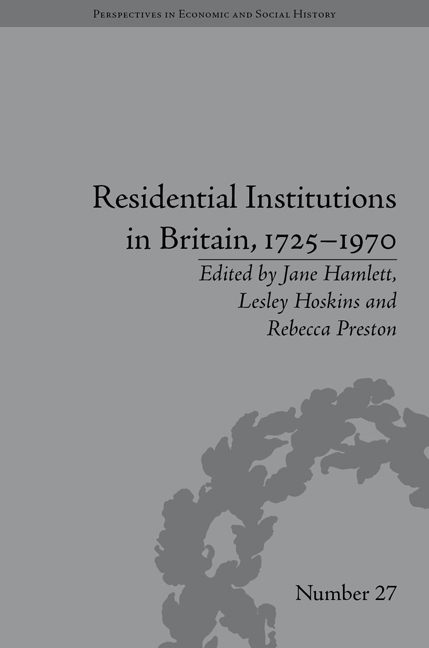Book contents
- Frontmatter
- Contents
- Acknowledgements
- List of Contributors
- List of Figures
- Introduction
- 1 Viewing the Early Twentieth-Century Institutional Interior through the Pages of Living London
- 2 ‘French Beef was Better than Hampstead Beef’: Taste, Treatment and Pauperism in a London Smallpox Hospital, 1871
- 3 From Asylum to Mental Hospital: Gender, Space and the Patient Experience in London County Council Asylums, 1890–1910
- 4 Refuge or Prison? Girls' Experiences of a Home for the ‘Mentally Defective’ in Scotland, 1906–1948
- 5 Paupers and their Experience of a London Workhouse: St Martin-in-the-Fields, 1725–1824
- 6 ‘A Veritable Palace for the Hard-Working Labourer?’ Space, Material Culture and Inmate Experience in London's Rowton Houses, 1892–1918
- 7 ‘The Place was a Home from Home’: Identity and Belonging in the English Cottage Home for Convalescing Psychiatric Patients, 1910–1939
- 8 ‘The Father and Mother of the Place’: Inhabiting London's Public Libraries, 1885–1940
- 9 ‘Discipline with Home-Like Conditions’: The Living Quarters and Daily Life of the Women's Army Auxiliary Corps in First-World-War Britain and France
- 10 Halls of Residence at Britain's Civic Universities, 1870–1970
- Notes
- Index
7 - ‘The Place was a Home from Home’: Identity and Belonging in the English Cottage Home for Convalescing Psychiatric Patients, 1910–1939
- Frontmatter
- Contents
- Acknowledgements
- List of Contributors
- List of Figures
- Introduction
- 1 Viewing the Early Twentieth-Century Institutional Interior through the Pages of Living London
- 2 ‘French Beef was Better than Hampstead Beef’: Taste, Treatment and Pauperism in a London Smallpox Hospital, 1871
- 3 From Asylum to Mental Hospital: Gender, Space and the Patient Experience in London County Council Asylums, 1890–1910
- 4 Refuge or Prison? Girls' Experiences of a Home for the ‘Mentally Defective’ in Scotland, 1906–1948
- 5 Paupers and their Experience of a London Workhouse: St Martin-in-the-Fields, 1725–1824
- 6 ‘A Veritable Palace for the Hard-Working Labourer?’ Space, Material Culture and Inmate Experience in London's Rowton Houses, 1892–1918
- 7 ‘The Place was a Home from Home’: Identity and Belonging in the English Cottage Home for Convalescing Psychiatric Patients, 1910–1939
- 8 ‘The Father and Mother of the Place’: Inhabiting London's Public Libraries, 1885–1940
- 9 ‘Discipline with Home-Like Conditions’: The Living Quarters and Daily Life of the Women's Army Auxiliary Corps in First-World-War Britain and France
- 10 Halls of Residence at Britain's Civic Universities, 1870–1970
- Notes
- Index
Summary
Psychiatric Aftercare and the Cottage Home
Cottage homes for convalescing psychiatric patients first appeared in England in the 1880s. Convalescent homes for the somatically sick had developed during the mid-nineteenth century, often located at the seaside or in the country, where they took patients for a time-limited interval after active treatment. Cottage homes provided similarly temporary residential care and recuperation for patients recently discharged from acute treatment within asylums. Although the homes discussed in this chapter were specifically reserved for the convalescent mentally ill, the term ‘cottage home’ had been applied to other institutions from the late nineteenth century. John Adams has described workhouse infirmary wards reserved for children as ‘cottage homes’. Similarly, Edward Shorter has found the term applied to turn-of-the-century sanatoria for nervous and mental disorders in North America. Its usage is also associated with Barnardo's homes for ‘rescued’ girls (though not boys) in the 1870s. The definition of ‘cottage home’ was, therefore, somewhat elastic. Nevertheless, in early twentieth-century British psychiatry it referred more specifically to a type of lay-managed institution for the temporary convalescence of psychiatric post-acute patients. This chapter explores how these homes influenced patients' experience of discharge, identity and belonging through residential psychiatric aftercare.
Access to the cottage homes was regulated through the Mental After-Care Association (MACA).
- Type
- Chapter
- Information
- Residential Institutions in Britain, 1725–1970Inmates and Environments, pp. 109 - 124Publisher: Pickering & ChattoFirst published in: 2014



